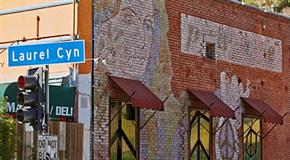Laurel Canyon Music, Vibe Moves To Grammy Museum
And yet from the quiet of the densely wooded canyon came a music revolution that would change popular culture.

The likes of David Crosby and Graham Nash worked on their music – or in some cases created new genres like folk-rock and country-rock – pretty much in anonymity during the 1960s and 1970s, in a place where no one bothered to go in those days unless they lived there.
Now, the sights and sounds of the canyon have been captured and transported from its narrow serpentine streets to downtown LA’s Grammy Museum in an exhibition called “California Dreamin’: The Sounds of Laurel Canyon 1965-1977.”
The exhibition, a senses-shaking assault of music, memorabilia and visuals hits as you enter a gallery that features everything from reminisces by Jackson Browne to hand-written lyrics by Frank Zappa and Gram Parsons.
There are brief video performances by the Turtles, music by the Eagles and the Doors, and scores of candid photos, like one of Joni Mitchell perched idyllically on a canyon hillside, playing a dulcimer.
But “California Dreamin’“ also seeks to document what its curator, Grammy Museum Executive Director Bob Santelli, believes is one of the most important and overlooked moments in pop music history.
While the media were documenting the folk music renaissance Bob Dylan helped launch in New York’s Greenwich Village in the early 1960s and the psychedelic scene that sprung from San Francisco’s Haight-Ashbury District a few years later, Santelli said, musicians who took up residence by the score in Laurel Canyon were actually doing much more.
They quickly launched several new music genres, Santelli said, including the laid-back, LA-centric singer-songwriter movement that came to flower with the emergence of Browne, Mitchell, James Taylor and others.
Although the canyon’s dirty brown hills rise up above Hollywood’s Sunset Strip and the neighborhood’s many music clubs and recording studios, many of the canyon’s streets were unpaved then, giving the place a rural, backwoods feel.
To this day the place only has one store and roads so narrow that on some of them two cars can’t pass unless one backs up.
Thus the Byrds were free to experiment pretty much uninterrupted and unbothered until they created music’s first true folk-rock album, merging electric-guitar chords with lyrics by Dylan and others to create “Mr. Tambourine Man.”
Nearby, Jim Morrison was creating the ethereal sounds that would make the music of the Doors everlasting, while Zappa was putting together his neo-classical arrangements from a faded mansion that silent-era movie star Tom Mix had once owned.
From a house on Lookout Mountain Road, Mitchell was drawing inspiration for the album Ladies of the Canyon, while boyfriend Nash was immortalizing the modest abode they shared in “Our House,” arguably his most beautiful song.
“I heard the Eagles writing songs up there, writing ‘Desperado,’ sitting around the piano. Don Henley, Glenn Frey and J.D. Souther, all on one piano bench, all sticking their hands on the keys,” said rock music photographer Henry Diltz, who lived there.
His iconic images fill a wall of the exhibit.
Along with those of Linda Ronstadt, Neil Young and others is the classic pose of Nash, Stephen Stills and Crosby sitting on the porch of a rustic canyon house. It would become the cover of their eponymous first album, Crosby, Stills and Nash.
The three, who formed rock’s first so-called supergroup, had been brought together at another canyon home, that of Cass Elliot of The Mamas & the Papas.
As to why all these musicians settled in Laurel Canyon and not, say Paris, in the 1960s and ‘70s, the answer is simple, said Mark Volman of the Turtles.
“It was cheap and musicians are cheap,” guffawed Volman, who rented a house for $280 a month in 1965 with Poco’s Richie Furay. “It housed musicians because musicians made no money in those days and when they did the record companies stole it.”
Eventually of course, they would make money, and would leave the canyon for neighborhoods where there was more than one store and the streets actually had sidewalks.
“You know what happens,” said Diltz, who moved to the San Fernando Valley. “You get married, right, and then you have kids. And when you have kids you have to move downhill to where the schools and the birthday parties and the supermarkets are.”

Meanwhile, in the years afterward, the canyon’s legacy brought in the wealthy, who priced out future generations of struggling musicians. Even the modest homes like the place Volman and Furay shared go for $1 million or more now.
“But Laurel Canyon was always more than just a scene,” Santelli said. “It was also a mindset.”
Until the end of November that mindset lives on the second floor of the Grammy Museum.
 Daily Pulse
Subscribe
Daily Pulse
Subscribe

